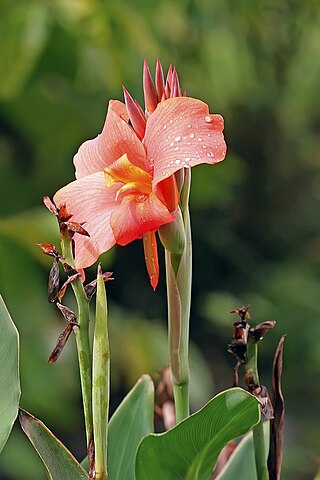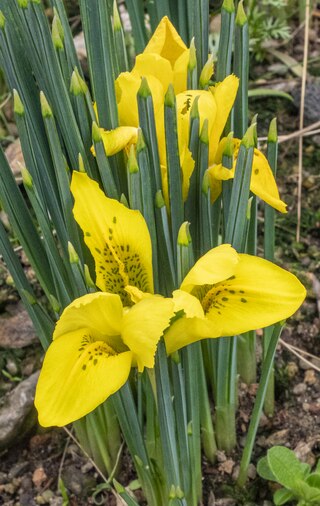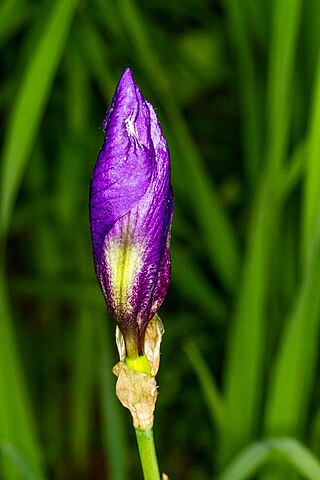
Canna or canna lily is the only genus of flowering plants in the family Cannaceae, consisting of 10 species. All of the genus's species are native to the American tropics and naturalized in Europe, India and Africa in the 1860s. Although they grow native to the tropics, most cultivars have been developed in temperate climates and are easy to grow in most countries of the world, as long as they receive at least 6–8 hours average sunlight during the summer, and are moved to a warm location for the winter. See the Canna cultivar gallery for photographs of Canna cultivars.

Iris is a flowering plant genus of 310 accepted species with showy flowers. As well as being the scientific name, iris is also widely used as a common name for all Iris species, as well as some belonging to other closely related genera. A common name for some species is flags, while the plants of the subgenus Scorpiris are widely known as junos, particularly in horticulture. It is a popular garden flower.

Acorus calamus is a species of flowering plant with psychoactive chemicals. It is a tall wetland monocot of the family Acoraceae, in the genus Acorus. Although used in traditional medicine over centuries to treat digestive disorders and pain, there is no clinical evidence for its safety or efficacy – and ingested calamus may be toxic – leading to its commercial ban in the United States.

Iris sibirica, commonly known as Siberian iris or Siberian flag, is a species of flowering plant in the family Iridaceae. It is a rhizomatous herbaceous perennial, from Europe and Central Asia. It has long green grass-like leaves, tall stem, 2–5 violet-blue, to blue, and occasionally white flowers. It is cultivated as an ornamental plant in temperate regions.

Iris pallida, the Dalmatian iris or sweet iris, is a hardy flowering perennial plant of the genus Iris, family Iridaceae. It is native to the Dalmatian coast (Croatia) but widely naturalised elsewhere. It is a member of the subgenus Iris, meaning that it is a bearded iris, and grows from a rhizome. It adapts well to different environments and is used in many different ways.

Iris foetidissima, the stinking iris, gladdon, Gladwin iris, roast-beef plant, or stinking gladwin, is a species of flowering plant in the family Iridaceae, found in open woodland, hedgebanks and on sea-cliffs.

The term "Japanese iris" encompasses three species of Irises cultivated in gardens or growing wild in Japan: hanashōbu, kakitsubata and ayame. Of these three species, I. ensata is the one most commonly referred to as "Japanese iris" outside Japan.

Iris japonica, commonly known as fringed iris, shaga and butterfly flower, is a native of China and Japan. It is a species in the genus Iris, in the subgenus Limniris and within the Lophiris section. It is a rhizomatous perennial plant, with pale blue, lavender or white flowers with an orange or yellow crest. It is cultivated as an ornamental plant in temperate regions.

Iris ensata, the Japanese iris or Japanese water iris, formerly I. kaempferi, is a species of flowering plant in the family Iridaceae, native to Japan, China, Korea and Russia, and widely cultivated as an ornamental plant. "Japanese iris" may also refer to I. sanguinea and I. laevigata, both native to Japan.

Iris variegata, commonly known as the Hungarian iris, is a plant species in the genus Iris, also in the subgenus Iris. It is a rhizomatous perennial from eastern Europe. It has dark green, ribbed leaves. The branched flowering stems can be as tall as the leaves, they can hold 2–3 flowers in summer. They are yellowish-white, with brown-purple veins on the drooping falls. It is very hardy and it is commonly cultivated as an ornamental plant in temperate regions. There are several cultivars.

Iris danfordiae, the dwarf iris or Danford iris, is a bulbous perennial plant in the genus Iris, it is classified in the subgenus Hermodactyloides and section Reticulatae. It is from Turkey in Asia. It has 2 gray-green or bluish green, thick leaves, short slender stem holding a scented flower, in shades of yellow. They are spotted olive-green or green and have a deep yellow or orange crest.
Iris albomarginata is a species in the genus Iris, in the subgenus Scorpiris. It is a bulbous perennial, from the mountains in the former Russian states of Kyrgyzstan and Tajikistan.

Iris fulva, also known as copper iris, is a species in the genus Iris, it is also in the subgenus Limniris and in the series Hexagonae. It is a rhizomatous perennial, endemic to the southern and central United States. It has copper-red to deep red flowers and bright green leaves.

Iris crocea is a species in the genus Iris, it is also in the subgenus Limniris and the series Spuriae. It is a rhizomatous perennial plant, found in Kashmir. It is cultivated as an ornamental plant. It is also commonly known as Golden Iris or Golden Flag. It was also known as Iris aurea for a long time, before that was regarded as a synonym of Iris crocea.

Iris orientalis is a species in the genus Iris; it is also in the subgenus Limniris and in the series Spuriae. It is a rhizomatous perennial plant, from Turkey and Greece, with white flowers with a yellow mark or blotch. It was also known as Iris ochroleuca for a long time. It is commonly known as yellow banded iris in the U.S. and Turkish iris in the UK but also has some other less common names. It is very hardy and has been known to naturalize in various countries. It is widely cultivated as an ornamental plant in temperate regions.

Iris humilis is a plant species in the genus Iris. It is also in the subgenus of Iris and in the Psammiris section. It is a rhizomatous perennial, with a wide distribution range from Europe to Russia to China, via Mongolia and Kazakhstan. It has sword-shaped leaves, a short stem and yellow flowers with an orange beard. It is cultivated as an ornamental plant in temperate regions.

Iris attica, the Greek iris, is a plant species in the genus Iris, it is also in the subgenus Iris. It is a rhizomatous perennial, from the mountains of the Balkans in Europe, within the countries of Greece, former Yugoslavia, Turkey and North Macedonia. It has sage green or grey-green leaves, that are sickle-shaped, a stout short stem and 2 variable flowers, in shades from yellow to purple. They have a white or blue beard. It is often called Iris pumila subsp attica, but is classified in most sources, as a separate species, although it is closely related to Iris pumila, as a possible parent plant. It is cultivated as an ornamental plant in temperate regions.

The identity of the plant first described by Carl Linnaeus as Iris florentina remains unclear, as of December 2021. In horticulture, it has been treated as a white-flowered variant of Iris × germanica, under names such as Iris germanica nothovar. florentina, Iris × germanica var. florentina and Iris × germanica 'Florentina'. Iris florentina has also been treated as the correct name for the true species also known as Iris albicansLange.

Iris sambucina, the elder scented iris, is a plant species in the genus Iris, it is also in the subgenus Iris. It is a rhizomatous perennial, from southern and central Europe. It has green, curved or sword-like leaves, tall round stem, multiple flowers in shades from brown violet, or brown-purple, to purple-violet, blue violet, mauve, and to purple. The large flowers are fragrant, with the scent of elderflowers, hence the name. It was first considered a separate species, then it was classified as a synonym of Iris germanica, before being classified as a separate species again, but with a hybrid origin from Iris pallida and Iris variegata. It is sometimes cultivated as an ornamental plant in temperate regions.

Iris sari is a species in the genus Iris, it is also in the subgenus Iris and in section Oncocyclus. It is from the rocky steppes and hills of Turkey. It has curved or straight leaves, cream, greenish or yellowish flowers which are variable and veined with crimson, purple-brown, reddish brown, reddish-purple or black. It has a dark maroon, rich crimson or brown signal patch and gold or yellow beard.






























